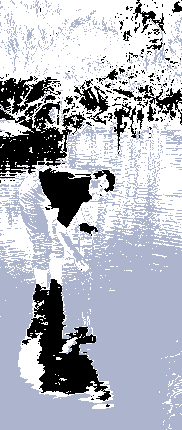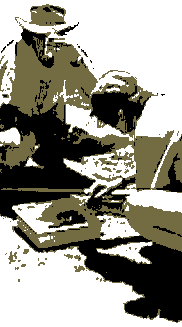

- conductivity compensated to 25°C. (milliSiemens/metre)
- salinity (ppt) [normally calculated from conductivity]
- dissolved oxygen (milligrams/litre) and/or % saturation
- temperature (degrees Celsius)
- pH
- turbidity (NTU)
- total phosphorus (milligrams/litre)
- total nitrogen (milligrams/litre)
Less used sites may be sampled only during the life of a research project, or when there are special events such as floods, unexplained fish or bird deaths and algal blooms, or just very infrequently. Some are on intermittent streams and are sampled only when there is flow.
Rarely measured sample types may be those which are not expected to change rapidly, are not relevant except at particular times or at a few sites, or which are too difficult or expensive to measure regularly. Some of the sample types not available here but occasionally measured are:
- pesticides
- herbicides
- water levels
- flow rates
- dissolved ions (chloride, sodium, bicarbonate, etc.)
- phytoplankton concentration
Other agencies which may have related information about the region include the Bureau of Meteorology, the Department of Agriculture, the Department of Biodiversity, Conservation and Attractions and the Fisheries Department.
Units of measurement
- Conductivity: The electrical conductivity of the water, measured at the site using a conductivity meter. Typical units are milliSiemens per centimetre or milliSiemens per metre (100 mS./m. = 1 mS./cm.). Since the conductivity is dependent to some extent on the temperature, the measured value is often adjusted mathmatically to the value at a defined temperature.
A rough measure of the salinity of "fresh" water, in milligrams per litre, can be derived from its conductivity in milliSiemens per metre by multiplying by six. More accurate calculations can be performed if the ionic composition of the water is known. The internationally recognised acceptable upper salinity limit for human drinking water supplies is 1000 milligrams per litre, at which concentration the water might taste faintly brackish; the salinity of seawater is about 35000 milligrams per litre (35 grams per litre).
- pH: The acidity of the water, measured at the site using a pH meter. pH is a dimensionless value, ranging from 1 (strong acid) though 7 (pure water) to 14 (strong alkali).
- Dissolved oxygen: The amount of oxygen dissolved in the water, measured at the site using a dissolved oxygen meter. The units are milligrams per litre and well aerated water typically has a value around nine milligrams per litre. The capacity of oxygen to dissolve in water is affected by both temperature and salinity, so sometimes the oxygen concentration is determined relative to the saturation concentration and expressed as a percent saturation.
- Temperature: How hot the water is, measured at the site using a temperature probe based on a thermistor (a heat-sensitive resistor). The units are degrees Celsius.
- Turbidity: The amount of light absorbed by a given sample water, measured using a Secchi disk (in situ) or a Morgan turbidity tube (with a water sample). The measurement relies on an observer determining at what point a standard set of markings can just be seen through the water, so the scale is not linear. The units are NTUs (Nephelometric Turbidity Units) and typical values range from one or two (very clear) to 30-400 (very muddy). The turbidity of a water sample is related mostly to the amount of suspended matter (animal, mineral and vegetable) in the water.
- Total phosphorus: The combined amount of phosphorus in particles and in substances dissolved in the water, measured chemically from a water sample. The units are milligrams per litre.
- Total nitrogen: The combined amount of nitrogen in particles and in substances dissolved in the water, measured chemically from a water sample. The units are milligrams per litre.
Sampling methods and quality control
There is no point in collecting water quality (or any other) data if you cannot have confidence that the measures which are finally recorded are a reasonably accurate and reliable statement of conditions at each site at the time of sampling. This confidence depends on the manner in which the water quality data were collected and the checks that were carried out to ensure the reasonableness of the results. The following procedures were used in the collection of the data presented via these web pages.
All catchment waterways measurements and samples were collected by community monitors contracted for the purpose for each catchment. Before the start of the sampling program, the monitors underwent a one and a half day, 'one on one' training program. During the course of the monitoring program, refresher training was also provided. At all times during the program technical support was available through the program manager who was based in Albany. In the case of the estuary data, a contractor with many years experience in waterways research, was employed by the Water and Rivers Commission to implement the field investigations for all the target estuaries along the south coast.
Prior to field trips community monitors followed a fixed procedure for checking the electronic water quality meters. The units used (WTW P4) were state of the art portable meters measuring electrical conductivity (which can be converted to salinity), pH, dissolved oxygen and temperature.
Routine control checks were carried out by registering the pH and conductivity probe responses to known standard solutions, pH 4 and 7 and conductivity standards 1.413 and 12.88 mS/cm. The temperature reading was checked against a standard thermometer. No standard was available to check the disolved oxygen reading however the probe could be easily calibrated in air, at any time.
Routine calibrations were also carried out using the above standard solutions. Shelf life recommendations for the standards were observed. The probes were considered reliable when the calibration parameters were within the manufacturer's specified ranges. The reliability of the measured values was considered very good if the meter readings were within 2% of the standard values and acceptable if they were within 5%. For values approaching 5% a re-calibration or instrument service was recommended. The calibration data were also recorded. In cases where erratic readings or error messages occurred and could not be rectified in the field the instrument was returned to the former Water and Rivers Commission for inspection, service or repair and in some cases replacement of the probes.
Water samples were treated according to recommended practices for total nitrogen and total phosphorus analysis. At collection they were uniquely labelled and later frozen. Samples were freighted direct to the laboratory in Perth in insulated containers and not kept for longer than one month.
Throughout the process from field to laboratory and database, the samples and data were accompanied by paperwork detailing the origin and nature of the information. All sites were registered and located by GPS. The data were reviewed by the program manager for likely errors and anomalous readings.
Further information
Information on making use of these data is available in the pamphlet Understanding Water Quality on the Swan Coastal Plain produced by the Swan River Trust and available from the Department of Water. Although it is written for the area around Perth, most of the information applies to water quality data generally.
